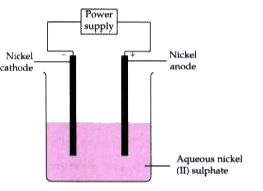A solution of sodium sulphate was electrolyzed using some inert electrode. The product at the electrodes are
O2,H2
O2,Na
O2,SO2
O2,S2O2−8
The correct Answer is:a
To determine the products formed at the electrodes during the electrolysis of a sodium sulfate (Na2SO4) solution using inert electrodes, we can follow these steps:
1. Identify the Ions in the Solution:
Sodium sulfate dissociates in water to form sodium ions (Na⁺) and sulfate ions (SO₄²⁻). The complete ionic dissociation is:
Na2SO4→2Na++SO2−4
2. Determine the Reactions at the Electrodes:
In electrolysis, oxidation occurs at the anode and reduction occurs at the cathode. The relevant half-reactions are:
- At the anode: Oxidation (loss of electrons)
- At the cathode: Reduction (gain of electrons)
3. Analyze the Anode Reaction:
The sulfate ion (SO₄²⁻) cannot be oxidized because its standard reduction potential (SRP) is less favorable than that of water. Therefore, water is oxidized at the anode:
2H2O→O2+4H++4e−
This reaction produces oxygen gas (O₂) at the anode.
4. Analyze the Cathode Reaction:
At the cathode, the sodium ion (Na⁺) cannot be reduced because its SRP is less favorable than that of hydrogen ions (H⁺). Therefore, water is reduced:
2H2O+2e−→H2+2OH−
This reaction produces hydrogen gas (H₂) at the cathode.
5. Combine the Reactions:
To find the overall reaction, we can add the half-reactions together. The half-reaction for the anode produces 4 electrons, while the cathode consumes 2 electrons. We need to multiply the cathode reaction by 2 to balance the electrons:
2(2H2O+2e−→H2+2OH−)
This gives:
4H2O+4e−→2H2+4OH−
6. Final Overall Reaction:
Combining the balanced half-reactions gives:
2H2O→O2+4H++4e−(anode)
4H2O+4e−→2H2+4OH−(cathode)
The overall balanced reaction is:
2H2O→2H2+O2
Products at the Electrodes:
- At the Anode: Oxygen gas (O₂)
- At the Cathode: Hydrogen gas (H₂)
Sodium sulfate dissociates in water to form sodium ions (Na⁺) and sulfate ions (SO₄²⁻). The complete ionic dissociation is:
Na2SO4→2Na++SO2−4
In electrolysis, oxidation occurs at the anode and reduction occurs at the cathode. The relevant half-reactions are:
- At the anode: Oxidation (loss of electrons)
- At the cathode: Reduction (gain of electrons)
The sulfate ion (SO₄²⁻) cannot be oxidized because its standard reduction potential (SRP) is less favorable than that of water. Therefore, water is oxidized at the anode:
2H2O→O2+4H++4e−
This reaction produces oxygen gas (O₂) at the anode.
At the cathode, the sodium ion (Na⁺) cannot be reduced because its SRP is less favorable than that of hydrogen ions (H⁺). Therefore, water is reduced:
2H2O+2e−→H2+2OH−
This reaction produces hydrogen gas (H₂) at the cathode.
To find the overall reaction, we can add the half-reactions together. The half-reaction for the anode produces 4 electrons, while the cathode consumes 2 electrons. We need to multiply the cathode reaction by 2 to balance the electrons:
2(2H2O+2e−→H2+2OH−)
This gives:
4H2O+4e−→2H2+4OH−
Combining the balanced half-reactions gives:
2H2O→O2+4H++4e−(anode)
4H2O+4e−→2H2+4OH−(cathode)
The overall balanced reaction is:
2H2O→2H2+O2
- At the Anode: Oxygen gas (O₂)
- At the Cathode: Hydrogen gas (H₂)
Topper's Solved these Questions
- ELECTROCHEMISTRYBOOK - CENGAGE CHEMISTRY ENGLISHCHAPTER - ELECTROCHEMISTRYEXERCISE - Exerciseassertion -Reasoning
25 Videos
- ELECTROCHEMISTRYBOOK - CENGAGE CHEMISTRY ENGLISHCHAPTER - ELECTROCHEMISTRYEXERCISE - Exerciseinterger
8 Videos
- ELECTROCHEMISTRYBOOK - CENGAGE CHEMISTRY ENGLISHCHAPTER - ELECTROCHEMISTRYEXERCISE - Exercisemultiple Correct Ansers
53 Videos
- D AND F BLOCK ELEMENTSBOOK - CENGAGE CHEMISTRY ENGLISHCHAPTER - D AND F BLOCK ELEMENTSEXERCISE - Archives Subjective
29 Videos
- GENERAL PRINCIPLES AND PROCESS OF ISOLATION OF ELEMENTSBOOK - CENGAGE CHEMISTRY ENGLISHCHAPTER - GENERAL PRINCIPLES AND PROCESS OF ISOLATION OF ELEMENTSEXERCISE - Archives (Subjective)
14 Videos
Similar Questions
Knowledge Check
Brine is electrolysed by using inert electrodes. The reaction at anode is
ACl−(aq)→1/2Cl2(g)+e−,Ecell=1.36VB2H2O(l)→O2(g)+4H+(aq)+4e−,Ecell=1.23VCNa+(aq)+e−→Na(s),Ecell=2.71VDH+(aq)+e−→1/2H2(g),Ecell=0.00VBrine is electrolysed by using inert electrodes. The reaction at anode is
ACl−(aq)→1/2Cl2(g)+e−,Ecell=1.36VB2H2O(l)→O2(g)+4H+(aq)+4e−,Ecell=1.23VCNa+(aq)+e−→Na(s),Ecell=2.71VDH+(aq)+e−→1/2H2(g),Ecell=0.00VBrine is electrolysed by using inert electrodes. The reaction at anode is
ACl−(aq)→1/2Cl2(g)+e−,Ecell=1.36VB2H2O(l)→O2(g)+4H+(aq)+4e−,Ecell=1.23VCNa+(aq)+e−→Na(s),Ecell=2.71VDH+(aq)+e−→1/2H2(g),Ecell=0.00V
Name:
an inert electrode and an active electrode.
View SolutionA dilute aqueous solution of CuSo4 is electrolysed using platinum electrods. The products at the anode and cathode are:
View SolutionAn aqueous solution of Na2SO4 is electrolysed using Pt electrodes. The products at the cathode and anode are respectively:
View SolutionWhen molten NaCl is electrolysed by using inert electrode, the product obtained al cathode is
View SolutionAn aqueous solution of nickel (II) sulphate was electrolyzed using nickel electrodes. Observe the diagram and answer the questions that follow

Name the cation that remains as a spectator ion in the solution.
View Solution
